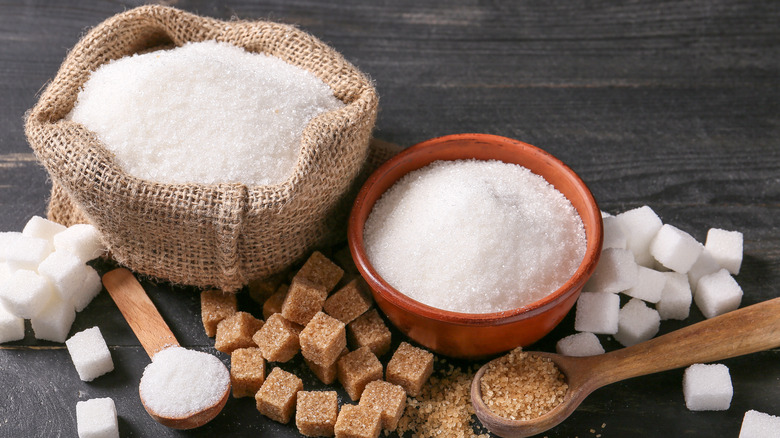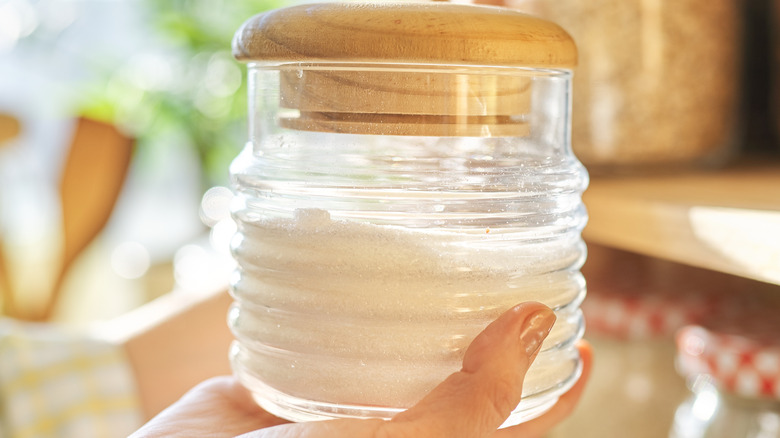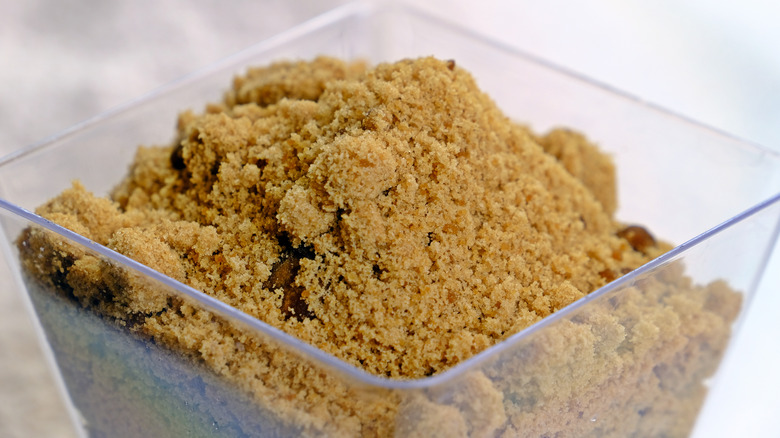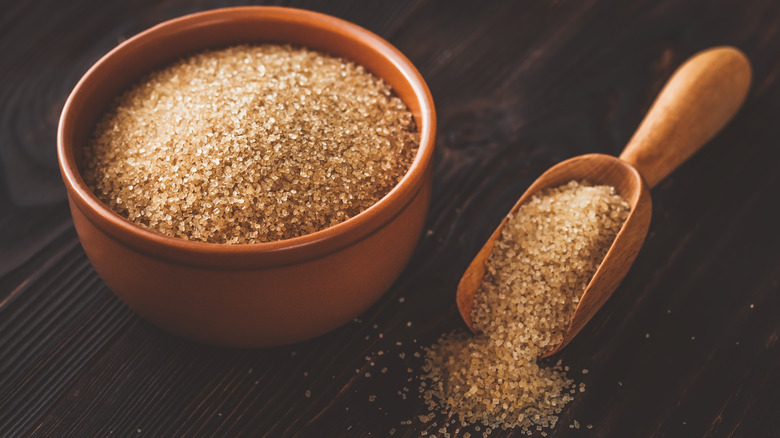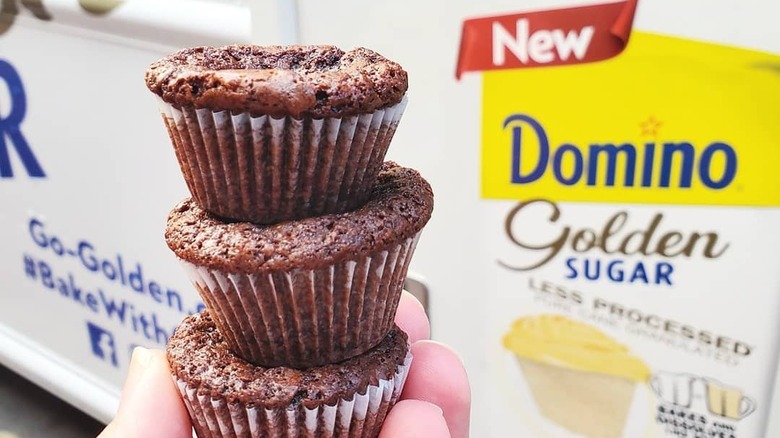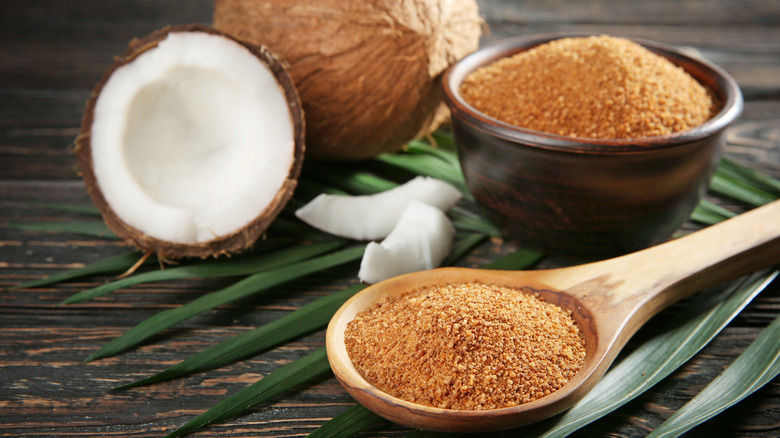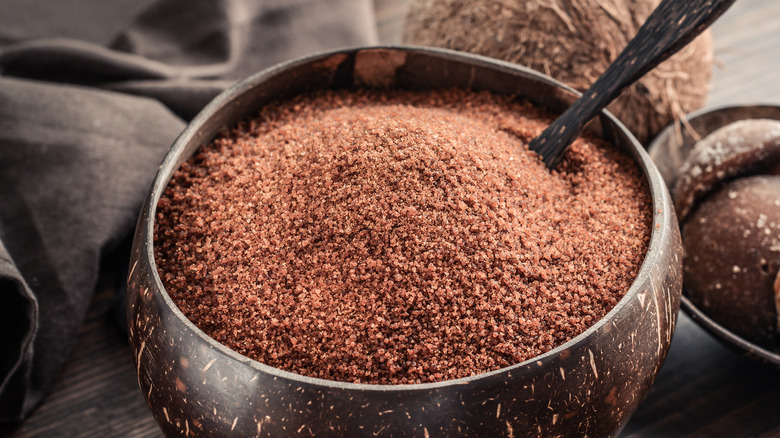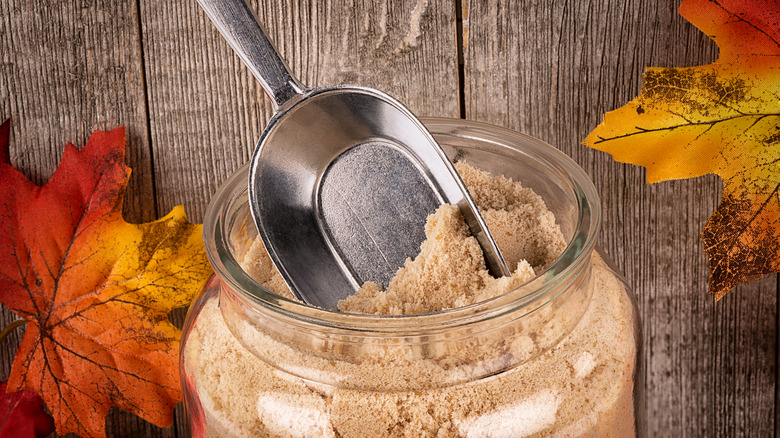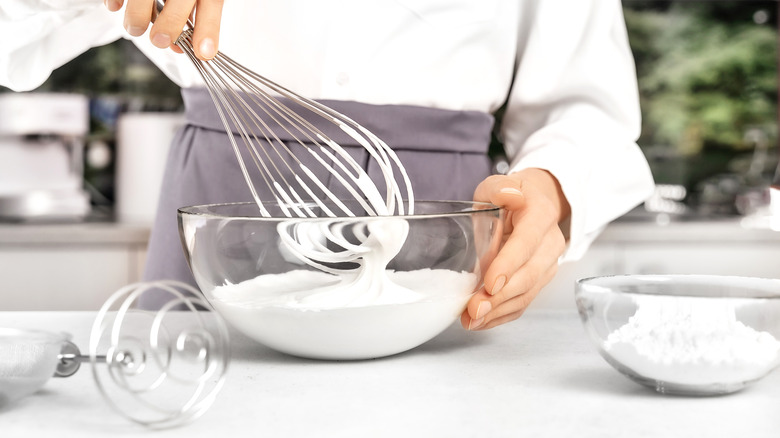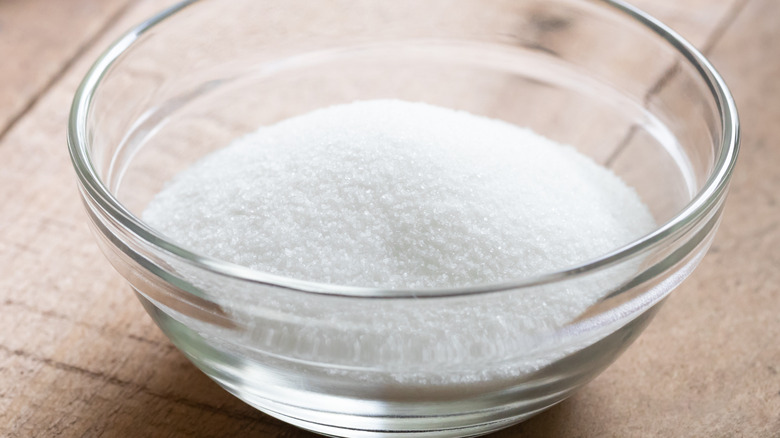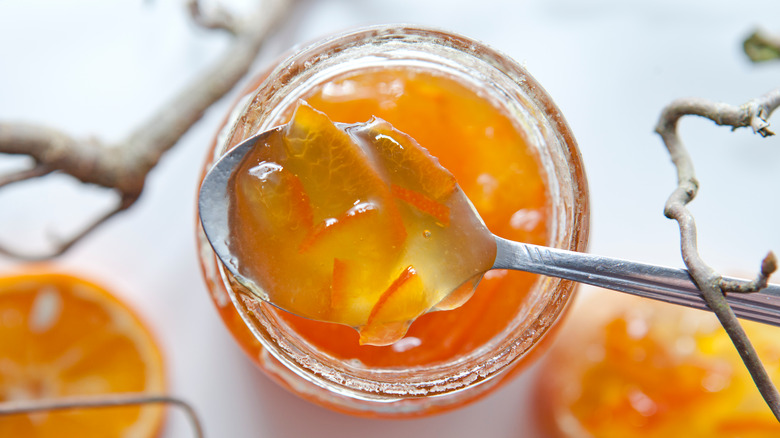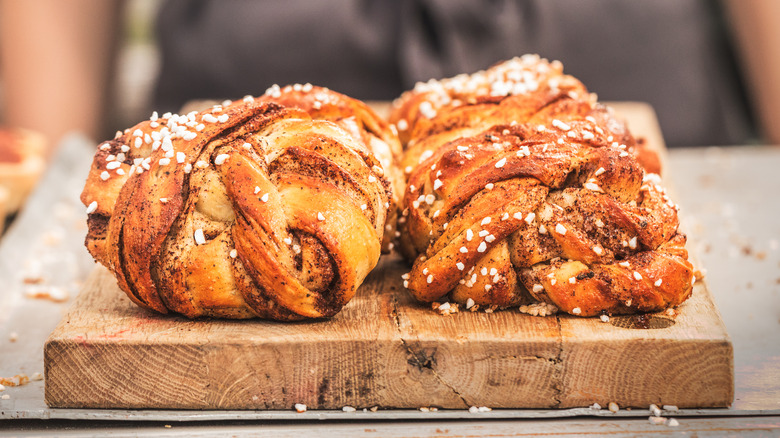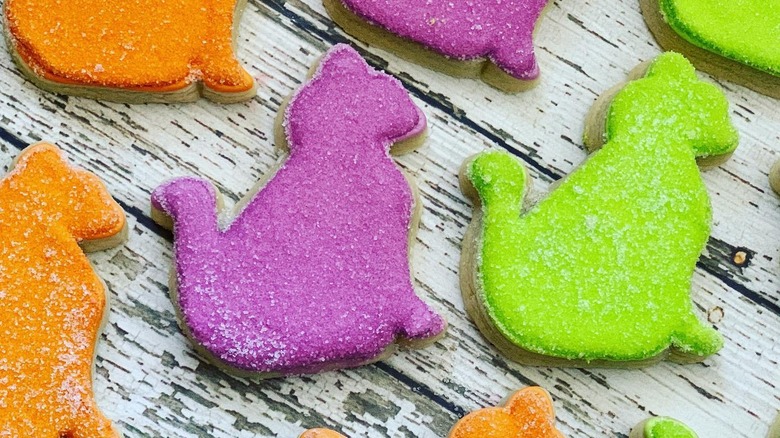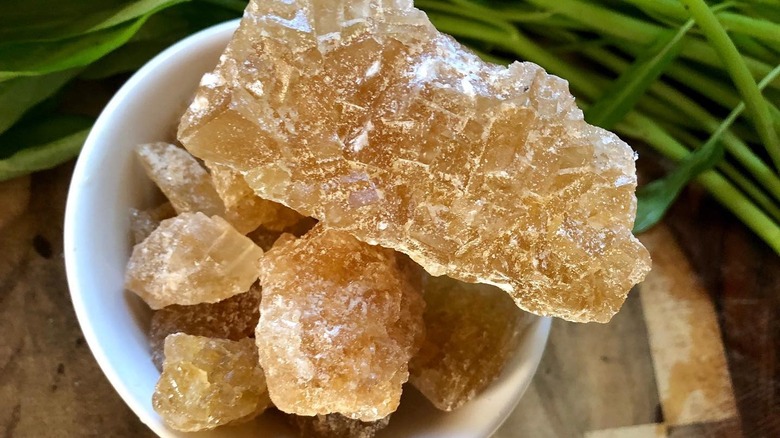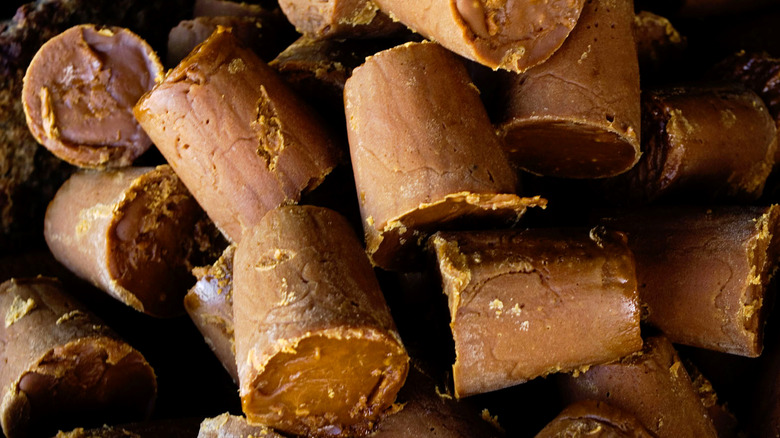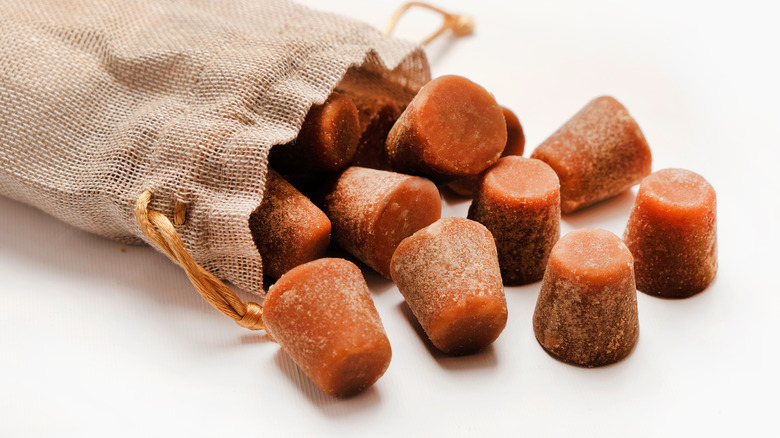15 Types Of Sugar And How To Use Them
If you love "The Great British Bake Off," chances are you've been tempted to try your hand at one of the technical challenges. Perhaps you've recreated a favorite signature recipe, only to find it calls for several ingredients you've never heard of, let alone have in your pantry.
Paul Hollywood's Iced Buns, for instance, is a recipe that requires three distinct kinds of sugar: caster sugar, jam sugar, and icing sugar. Do you really need all of these different sugars? Can't you substitute plain old white sugar for everything and call it a day? As it turns out, there are differences that do not always allow for substitutions. There are many types of sugar beyond these three, but what makes them unique? How is each one meant to be used?
We're answering these questions and more so that the next time you encounter one of these sugars in a recipe, you'll know exactly what to do.
White sugar
Let's start with white sugar. Known casually as table sugar, this is what you're most likely to find on the counter of your local coffee shop, the baking shelf of your mom's pantry, and in grocery aisles labeled simply as "sugar."
White sugar comes from sugar beets or sugarcane, both naturally high in a type of sugar called sucrose, per Britannica. Specialized refining processes extract that sucrose, boil it, and spin it in a centrifuge to separate pure sugar crystals from the rest of the syrupy liquid. Those pure sugar crystals go on to become granulated sugar, and what's left behind is mostly molasses — the dark, sweet byproduct of sugar refinement (via the Canadian Sugar Institute). Sugar crystals are then purified several times, resulting in sugar that's 99.95% sucrose.
While beet sugar is now good to go, cane sugar still needs to be bleached. Britannica explains this is done using bone char, which is exactly what it sounds like: charcoal made with animal bones. Don't worry, though — this doesn't mean there are bone remnants in your sugar (there aren't). It does, however, mean white sugar from sugarcane isn't technically vegan by some definitions, so some brands note where their sugar comes from on the label.
On top of being used to sweeten a huge variety of recipes from savory to sweet, Fine Cooking highlights granulated sugar's ability to make baked goods tender and deepen color and flavor as it caramelizes.
Brown sugar
You might think brown sugar is a less refined version of white sugar, but that's actually not the case at all. Remember the molasses that's left behind when sucrose crystals are extracted from sugarcane syrup to make white sugar? That molasses is added back into white sugar to make brown sugar in an additional step. Technically, brown sugar is more processed, but that doesn't make it any better or worse for you than white sugar, as Food Insight points out.
Molasses gives brown sugar a darker color and a richer, more complex flavor compared to white sugar. It also adds moisture, which is why white and brown sugar can't always be used interchangeably, especially when baking. That's not to say your recipes won't work at all if you swap them out. However, they won't turn out the way they were intended if the recipe calls for brown sugar and you opt to use white. That's because brown sugar makes baked goods softer, chewier, and darker while adding a hint of caramel flavor.
Brown sugar can be light brown or dark brown. Light brown is more versatile and typically what a recipe means when it lists "brown sugar" in the ingredient list. Dark brown has nearly twice the molasses for a deeper, more robust flavor (via Fine Cooking). You can use either, but the flavor and texture of your final product might change a bit.
Raw sugar
Raw sugar isn't actually raw, but it is less processed than white or brown sugar (via ABC News). What Sugar Blog explains that instead of going through multiple rounds of crystallization and centrifuging as refined sugar does, raw sugar only goes through one. This results in sugar crystals that retain a thin layer of their original molasses — more than white sugar, but less than what gets added back to brown.
Raw sugar goes by many different names, including cane sugar, turbinado sugar, Demerara sugar, and muscovado sugar. While they all come from sugarcane and are essentially interchangeable, they can vary slightly in crystal size and flavor. MasterClass writes that Demerara sugar, for example, has a subtle toffee taste and large, crunchy crystals, great for garnishing desserts. Luke Duncan, founder of Eli Mason cocktail mixers, told the Chicago Tribune that Demerara syrup "fares exceptionally well in specialty cocktails grounded on molasses-based rums." Meanwhile, muscovado sugar is sticky with a medium-sized crystal. It's a popular choice for chocolates, baked goods, warm drinks, savory sauces, and marinades, according to The Spruce Eats.
While there's a common misconception that raw sugar is better for you than refined, they have the same amount of calories, and any additional nutrients are minimal. That's not to say it isn't useful, though — raw sugar offers a unique flavor and can be used to replace refined sugar in many recipes. Just know that, despite its color, it performs more similarly to white sugar than brown.
Golden sugar
Golden Sugar might be one of our favorites based on the name alone. It's unique on our list because it's only produced by a few brands, most notably Domino. Domino, producer of 2.2 million metric tons of sugar a year (as reported by Delish), released Golden Sugar in 2019. While its production process is proprietary, the brand does tell us that Golden Sugar comes from sugarcane and is processed less heavily than white sugar. It retains both its unique golden color (lighter even than light brown sugar) and just a hint of molasses.
Domino says Golden Sugar can be used just like white sugar, and in equal amounts. That makes sense, given it's essentially another version of raw sugar. Paula Summers, ASR Group's vice president of marketing, says Golden Sugar was developed to help bakers "celebrate life's sweetest moments, but now with a less processed alternative." Domino also explains that while white sugar takes seven steps to process, Golden Sugar only takes three.
Golden Sugar can be used in everything from cookies and pies to coffee and tea. Its mellow flavor makes it ideal for recipes that crave a hint of molasses flavor without overwhelming any of the other ingredients. This is especially helpful if you're cooking or baking with spices you want to shine, like cinnamon or nutmeg.
Coconut sugar
Coconut sugar, sometimes called coconut palm sugar, looks a little like raw sugar but comes from a completely different place. That place is — you guessed it — a coconut palm tree. Nectar collected from the flowers of the coconut palm tree is boiled until the water evaporates, and what you're left with are little crystals of coconut sugar (via Healthline).
Since coconut sugar comes from the flowers and not the coconuts themselves, it doesn't actually taste like coconut. Instead, it has a sweet, earthy caramel flavor. Bon Appétit recommends coconut sugar as a white sugar substitute because it's quick to dissolve and can be used in a one-to-one ratio. That said, there's a chance that your baked goods won't turn out quite as moist or chewy if you use coconut sugar rather than white. If you need to substitute coconut sugar, turbinado is our number one choice.
Like raw sugar, coconut sugar is often thought of as a healthier alternative to refined sugar because it's less processed and contains additional nutrients. When you break it down, though, the total vitamin and mineral content of any type of sugar is minimal. Furthermore, the difference between various types is modest at best. That said, research suggests coconut sugar has a lower glycemic index than sugar that comes from sugarcane. That means it takes longer to digest and won't spike your blood sugar quite as much or as quickly.
Palm sugar
Palm sugar is often confused with coconut sugar, but while coconut sugar is made with nectar from palm tree flowers, palm sugar is made using sap from palm tree trunks in a process that The Spruce Eats compares to maple syrup. According to Spiceography, it's common in traditional Asian recipes and tastes a little bit like smokey brown sugar. There are also two distinct types: Indonesian palm sugar and Thai palm sugar. Of the two, Indonesian palm sugar is darker and has a more robust taste.
Palm sugar is sold in the United States, but it's often mixed with cane sugar to make it go further. This is because palm sugar can be time-consuming and therefore expensive to produce. This obviously alters the taste a bit, so if palm sugar is the star ingredient in whatever recipe you're making, check the label to see if it's 100% palm sugar or a mix of the two. If you're looking for a close palm sugar substitute, coconut sugar is probably your best bet.
Maple sugar
If you love maple syrup, this one's for you. Just like palm sugar, maple sugar comes from the sap of a tree — only this time, it's a maple tree. Maple syrup is boiled until most of the liquid has evaporated and only crystallized granules of maple sugar remain. Today describes it as having a rich maple flavor with hints of caramel and notes that it's actually lower in calories than refined sugar when compared tablespoon-to-tablespoon (30 calories in a tablespoon of maple sugar vs. 48 calories in a tablespoon of refined sugar).
Maple sugar is also a little bit sweeter than refined sugar, so you can actually use less of it — 3/4 cup of maple sugar for every cup of refined sugar — for the same sweet result. If you like the flavor of maple, you can use it in pretty much any recipe that calls for white sugar. To start, try mixing it into your pancake, waffle, or muffin batter for a unique new spin. Use it to add a whisper of maple flavor to coffee or tea, or toss it with carrots before roasting for a tasty, caramelized dinner side.
Icing sugar
Icing sugar is just another name for confectioners' sugar, which is another name for powdered sugar. To make it, white granulated sugar is ground into fine dust and mixed with cornstarch to make it light and fluffy. This keeps it from sticking or "caking" together, but as BBC Good Food notes, the anti-caking agent may vary based on the country you're buying it in.
Because icing sugar is fine, it dissolves faster than any other sugar on this list. That makes it the top choice for things like icing (surprise!), fudge, and whipped cream, all instances where smooth texture is a must. You can also use icing sugar in shortbread or cookies in place of white sugar for a crumblier texture. It can also be sprinkled over stencils to add patterns to the tops of cookies, cakes, and brownies. One thing that icing sugar isn't great for is sweetening drinks, as the cornstarch can leave behind an odd flavor.
In a pinch, you can make your own powdered sugar using white sugar, cornstarch, and a high-powered blender or a spice grinder (a food processor probably won't have the necessary horsepower). Just blend a tablespoon of cornstarch with a cup of sugar for 30 seconds or so, until it reaches powdered sugar consistency. You can also leave the cornstarch out if you don't have any, but your homemade icing sugar just won't work quite as well in frosting or glaze recipes.
Caster sugar
Caster sugar falls in between white sugar and icing sugar in terms of texture — it isn't quite powdered, but its sugar crystals are very fine. While it's more common in recipes from the UK, you can usually find it at stores in the United States labeled as "superfine sugar" or "baker's sugar."
As Allrecipes explains, caster sugar is ideal for baked goods that you want to be especially soft and airy (like meringues, soufflés, and angel food cake) because it dissolves quickly and incorporates seamlessly into batters and doughs. In fact, Mary Berry herself says to use caster sugar for "whisked sponges, cream mixtures, and meringue" in her cookbook titled the "Mary Berry Baking Bible." Food52 warns against using caster sugar as a substitute for powdered sugar, though, as it's a little too coarse for things like buttercream frosting.
If you don't have caster sugar, you can usually get away with substituting regular white sugar — just know your final product might be a little grittier. It might also be a little less sweet, as a cup of granulated sugar is, by weight, less than a cup of caster sugar. You can also make your own caster sugar in the same way you can make your own icing sugar — just use white sugar and a blender, spice grinder, or even a food processor. The sugar doesn't need to be ground all the way into a powder (via Food Network).
Jam sugar
Jam sugar (commonly sold as "gelling sugar" in the United States) is, as its name suggests, made specifically for making jams and jellies. To that end, Cook's Info explains that jam sugar is actually a mix of white granulated sugar, citric acid, and pectin, all essential ingredients to make jams and jellies.
Preserve & Pickle notes pectin, a type of carbohydrate found naturally in fruit, is particularly important because, when heated, it dissolves and forms new bonds that "set" the jam, turning it into a firm, delicious gel. Citric acid is important, too, as it's pectin's partner in crime. If you'll indulge us for a mini science lesson, this is because pectin, on a molecular level, is made up of negatively charged ions. Negatively charged ions don't like to play nice with each other, which is a problem when it comes to pectin re-forming the bonds that jelly needs. That's where citric acid comes in. It adds positively charged ions that neutralize pectin's negative ones, and voilà!
Jam sugar comes in several strengths, from 1:1 (which requires equal parts fruit and sugar for the sweetest results) to 3:1 (which requires three times as much fruit as sugar). The "stronger" the jam sugar, the less of it you need to use. While you don't need it to make jams and jellies (you can just use pectin, citric acid, and sugar as separate ingredients), the predetermined ratio makes it much easier.
Pearl sugar
Pearl sugar or nib sugar is a special large-grain sugar common in Europe and most often used as the finishing touch to baked goods like pastries, cookies, and cakes to provide a nice, sweet crunch. It's made by compressing granulated sugar crystals into larger granules reminiscent of little pearls (hence the name) and known for their ability to stand up to the heat of an oven without melting (via Cook's Illustrated).
Pearl sugar comes in two sizes. The smaller is Swedish pearl sugar and the larger is Belgian pearl sugar. Swedish pearl sugar is used as decoration while Belgian pearl sugar is used almost exclusively in Belgian Liège waffles. Since the large sugar pearls don't fully melt as the waffles cook, they leave little pockets of caramelized, sugary goodness that give the waffles a fluffy brioche-like center and sweet, crisp crust.
While pearl sugar can be difficult to find in the US, you can order it online or make it yourself in one of three ways. The first, MasterClass explains, is to mix sugar and water in a small sauce pot and heat slowly until little round clumps form. The second is to mix sugar and maple syrup, spread it over a plate, let it dry overnight, and then break it up into pieces. And the third is to fill a plastic bag with sugar cubes and smash them up with a kitchen mallet. Just know that for Liège waffles, only the real deal will do.
Sanding sugar
Sanding sugar is a granulated sugar used for decorating baked goods like cookies, muffins, and cakes. It comes in a variety of crystal sizes and bright, colorful hues. According to The Spruce Eats, sanding sugar is made up of incredibly pure sucrose crystals about the same size as a grain of sand. This makes them a little larger than your standard, run-of-the-mill granulated sugar. It's made using raw sugar that's melted, clarified, and recolored. It is recrystallized, dyed with food-grade coloring, and coated in a thin layer of edible wax and glaze for a bright, polished shine.
Sanding sugar is an easy way to give baked goods a sweet, colorful sparkle. Just take a look at how Martha Stewart's genius decorating hack transforms simple sugar cookies with two sizes of sanding sugar rolled around the edges. It's also an essential ingredient in Fairy bread, a birthday party tradition in Australia and New Zealand, and can be used to create intricate scenes like the one in the Bob's Burgers Valentine's-themed Cherry Pie that had Reddit swooning.
If you need a substitute, The Spruce Eats recommends pearl sugar or sprinkles. Raw sugar works, too, as far as texture goes. It will just be tan instead of colorful, which misses the point a bit when it comes to decorating. You can, however, make your own sanding sugar by adding a drop of food coloring to a plastic bag filled with white sugar and shaking it up.
Rock sugar
Rock sugar is popular in China where it's sold in irregular, gold-colored, crystallized "rocks" about an inch in diameter (via Cook's Info). The Woks of Life explains that the process for making rock sugar likely came about in the seventh century A.D. when a monk in Sichuan Province boiled sugarcane juice until it became a thick syrup. The syrup was crystallized over a period of a few days, resulting in large chunks of hard sugar.
Rock sugar can be either white or brown, depending on how much molasses it contains. Despite its golden color, it doesn't have any of the caramel flavors that are notable in raw sugar, brown sugar, coconut sugar, etc. Instead, it's purely and subtly sweet (less so than white sugar), making it ideal to add just a hint of sweetness to tea, marinades, sauces, soups, poultry dishes, and more. You can even use it to decorate cakes.
Regardless of how you decide to use it, you'll need to break it down into smaller pieces first — grab a kitchen mallet or a mortar and pestle and get to work! If you're looking for something less labor-intensive, you can dissolve rock sugar in water to make a simple syrup. Just know that it might take a while to completely dissolve. If you need a good substitute for rock sugar, you can generally use one tablespoon of white sugar for each sugar "rock" the recipe calls for.
Panela
Panela, also called piloncillo, is an unrefined sugar popular in Central and South America. As shared by Martha Stewart, it's made using crushed cane sugar that's melted, boiled, poured into molds to harden, and then typically sold as cones, blocks, or discs. Since it's unrefined, panela contains all the original molasses in cane sugar (whereas with refined sugar, that molasses is removed). That gives it a complex caramel flavor that adds a sweet decadence to traditional Latin American recipes, like those for dried fruit, canelazo (cinnamon iced tea), café de oya (a sweetened coffee), mole, pastries, and more.
You can usually find panela at Latin American grocery stores, and it might even be in liquid or granulated form. If it's in traditional blocks, though, you'll need to crush them up in your food processor. You can stick them in the microwave for a few seconds to soften them and make them easier to chop up, grate bits off as you need them, or melt the blocks down on the stove before adding to your recipe.
Serious Eats recommends panela in recipes with cinnamon, orange, anise, and vanilla. You can also use it to enhance the smokiness of chili and add richness to Mexican champurrado, a corn-thickened, spiced hot chocolate. If you need to substitute panela, you can use white, brown, or raw sugar in a one-to-one ratio. We'd recommend brown or raw sugar, if possible, to retain some of that molasses flavor.
Jaggery
Like panela, jaggery is an unrefined sugar. In many ways, it's another name for the same product as similar versions of unrefined, non-centrifugal sugars that exist throughout Asia, Latin America, and the Caribbean. They're known by many different names, from jaggery, panela, and piloncillo to gur (India), tapa dulce (Costa Rica), namtan tanode (Thailand), gula melaka (Malaysia), and kokuto (Japan) (via Healthline).
Jaggery is primarily made from sugarcane in Asia and Africa. It comes in a spectrum of hues, from light gold to dark brown, and is graded based on its color. Lighter shades are considered higher quality and contain more than 70% sucrose (remember, white sugar is 99.95% sucrose).
Because it contains some beneficial nutrients that are removed with molasses in refined sugar, jaggery is gaining traction in the United States as a "superfood sweetener." That said, jaggery is still sugar, and you would have to eat a lot of it for those trace nutrients to make a difference. Like all the sugars on this list, use it for the flavor rather than any supposed health benefits.
Jaggery can be grated, broken up, or melted and used as a replacement for refined sugar. It goes particularly well with coconut, peanuts, and condensed milk in traditional Asian and African desserts, like jaggery cake and chakkara pongal, a mix of milk and rice.
